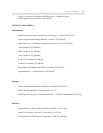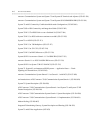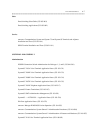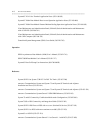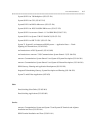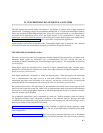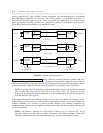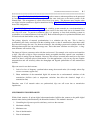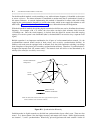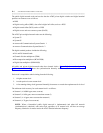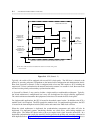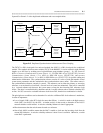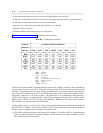SYNCHRONIZATION OF DIGITAL FACILITIES B-3
_ ______________________________________________________________________________________
_ ______________________________________________________________________________________
_ ______________________________________________________________________________________
Notice in figure B-1-B, Options for Synchronization, that the overrun or underrun problem can be prevented
by forcing the channel bank transmitter to operate at the same clock rate as the receive portion of the
channel bank. This arrangement is called channel-bank loop timing. This becomes more complex when
two digital switches terminate a digital transmission facility. Figure B-1-C, Options for Synchronization,
shows this configuration.
In figure B-1-C, Options for Synchronization, each switching system transmits at a rate determined by a
reference clock. Unless the received digital bit stream arrives at the same clock rate as its internal clock
rate, slips will occur. To prevent or minimize slips, it is necessary to force both switching systems to
synchronize on a common reference clock rate (F0). Both will then be part of a synchronized network, and
will read and write their buffers as they should.
The primary objective of network synchronization is to minimize the slip rate. This is done by
synchronizing the clocks associated with the switching nodes so that all transmissions from these nodes
have the same average line rate. For short-term intervals, the switching-system receive buffers absorb the
difference between the line rate and the average rate. These short term variations are called jitter. A long-
term difference will result in a slip.
The impact of slips on a customer varies with the services used. For example, voice services are insensitive
to slips. Slip rates as high as 20 per second are barely perceptible; therefore, speech is not considered a
limiting factor in setting slip-rate standards. However, data services are much more sensitive to slips since
each bit of data is a discrete piece of information. For data applications, a slip (at any slip rate) requires
retransmission and will adversely affect the throughput and degrade performance of data transmission
facilities.
Slips can occur for two basic reasons:
1. Lack of or loss of frequency synchronization among the network nodes (for example, when slips
occur at a constant, regular rate)
2. Phase modulation of the transmitted digital bit streams due to environmental variations of the
transmission facilities (such as temperature variations that affect the electrical length of a
transmission line)
Therefore, even if all network nodes are synchronized, slips can still occur due to transmission
impairments.
SYNCHRONIZATION HIERARCHY
Within North America, all private digital telecommunications facilities that connect to the public digital
network must obtain synchronization by the hierarchical method. This method is based on:
1. Controlling the slip rate to provide satisfactory service to the customer
2. Maximum reliability
3. Minimum costs
4. Ease of administration
5. Ease of maintenance



